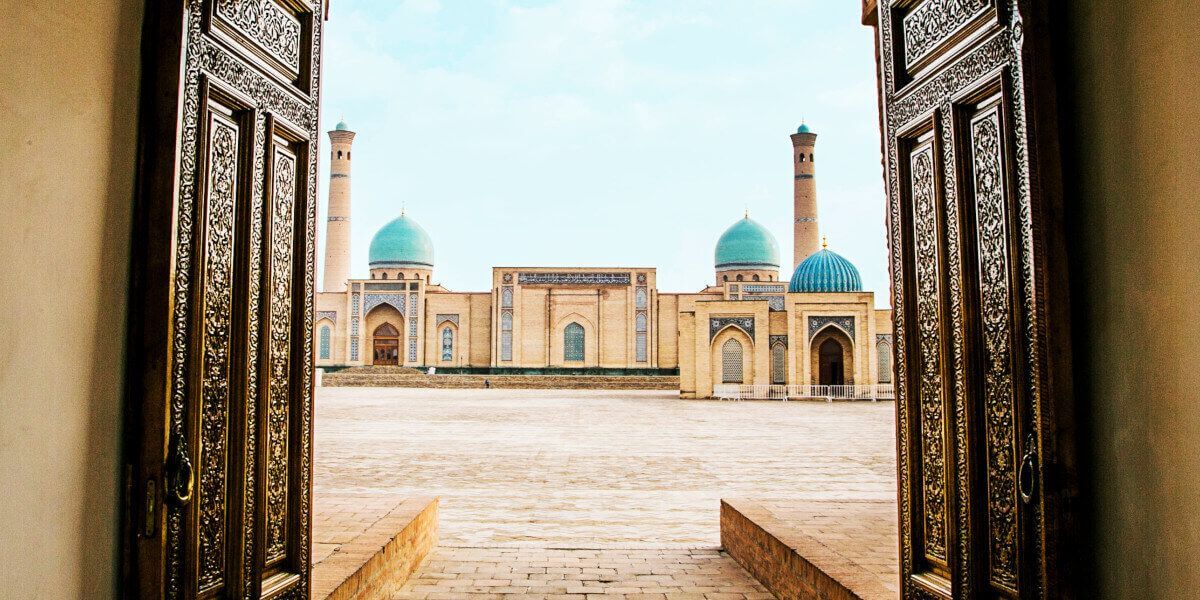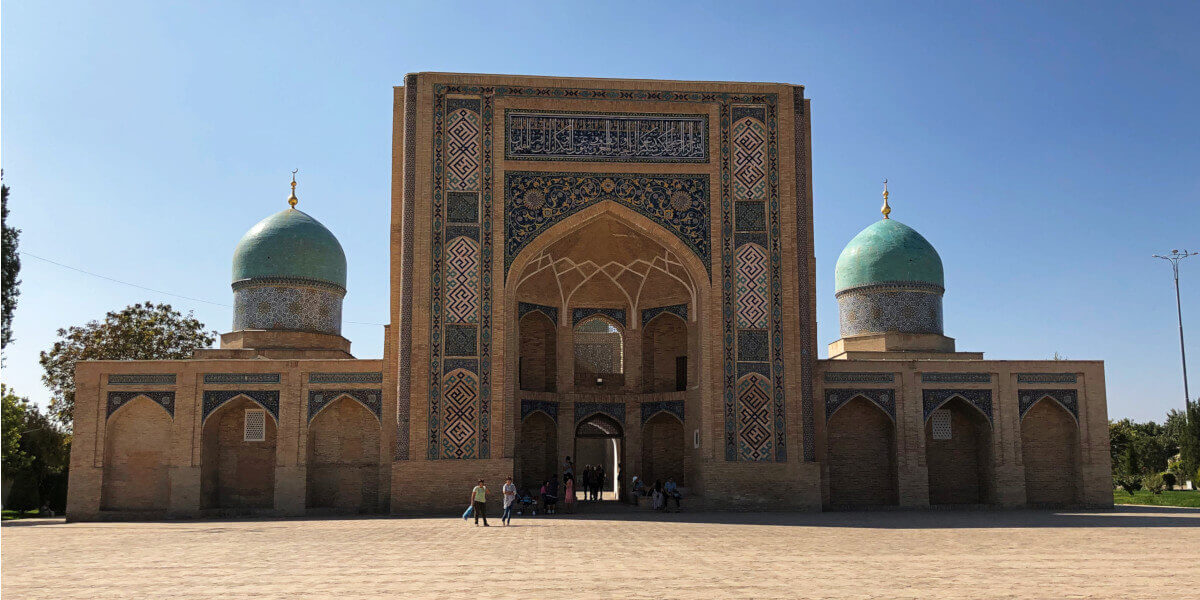The Khast-Imam Complex consists of the Abu Bakr Kaffal al-Shashi Mausoleum, the Namozgokh Mosque, the Barak-khan Madrasah, the Tillya Sheikh Mosque, the Muy Muborak Madrasah (where the famous Usman Koran is kept) and the Khast-Imam Mosque.

Abu Bakr Kaffal al-Shashi Mausoleum
Abu Bakr Muhammad Kaffal al-Shashi was born in Tashkent in 903 as the son of a locksmith. The nickname “Kaffal” means “a man who makes locks”. However, Abu Bakr did not want to learn his father’s profession and studied first in a madrasah in Tashkent, later in Samarkand and finally in Baghdad, the capital of the Arab caliphate, where he spent most of his life.
Abu Bakr became famous as an interpreter of the Koran and the Sunna, the holy legend about the life of the Prophet Mohammed. He became a follower of Shafi’i Madhab, one of the four canonical schools of Islamic jurisprudence. He wrote great poems and works about philosophy.
At the end of his life, Abu Bakr returned to his homeland. At that time, the Arab caliphate fought there with the Turkish ruling dynasty of the Karakhanids, which gradually took over the areas and founded the Karakhanid Empire. Around 960, the Karakhanids converted to Islam, whereby Abu Bakr is ascribed a leading role. Therefore people called him Khazrat Imam or Khast Imam, i.e. “holy Imam”.
Abu Bakr died in 976 and was buried in a mausoleum at the Khast-Imam complex. Legend has it that there were more mausoleums at the same place, but time and earthquakes destroyed them. Today’s mausoleum was built in 1541 by the famous architect Gulyam Hussein and decorated by the calligrapher Kudrat with characters, the so-called handwriting of the souls. Around the mausoleum, the complex was gradually built and can still be admired today.
In addition to Abu Bakr himself, two other personalities are buried in the mausoleum: Zayniddin Mahmud Vasifi (famous writer) and Babakhan Eshon, who turned to Stalin in 1943 with a successful request to restore the Islamic centre in Tashkent.
BARAK-KHAN MADRASAH
In 1485 the famous writer Zayniddin Mahmud Vasifi, a pupil of the famous Uzbek poet Alisher Navoi, was born in Herat (today’s Afghanistan). Due to an invasion of the Persian Shah, he had to leave Herat and move to Tashkent in 1515. To attract the attention of Tashkent’s ruler, he wrote a great poem in honour of Tashkent. The ruler liked it so much that he appointed Zayniddin Vasifi as the teacher of the heirs to the throne. One of these students, Navruz Ahmad (called Barak-khan), decided to have a madrasah built for his teacher to work there as Mudaris (rector). The construction of the madrasah dates back to the first half of the 16th century and is one of the great architectural works of the Khast-Imam complex.
The building was damaged several times by natural disasters, worst of all in the 19th century. Due to the various renovations, the original appearance of the madrasah has not been preserved. It now comprises two other old buildings, one of which was the tomb of Tashkent rulers.
During the Soviet era and until 2008, the Barak-khan Madrasah was used as the headquarter of the Central Asian Muslim Spiritual Council. Today it is a craft centre.

Khast-Imam Mosque
The new mosque of Tashkent was built in 2008 and named after Abu Bakr Kaffal al-Shashi. It was built in the tradition of Tashkent architecture. However, the 54 meter high minarets are unusual since mosques were usually built without minarets in Tashkent due to the seismic activity.

NAMOZGOKH MOSQUE RESP. ISLAMIC INSTITUTE
Next to the Mausoleum of Abu Bakr is the Namozgokh Mosque, built during the Kokand Khanate period. This mosque was created to enable garrison soldiers from Kokand to celebrate Eid-al-Fitr and Eid-al-Adha (religious holidays in Islam) and hold their prayers in the conquered Tashkent.
Since the Soviet era, there has been an Islamic institute in the mosque, which produces a small number of graduates each year. It was the only place that trained Muslim theologians in the former Soviet Union.
Today, the building named after the Imam Al-Bukhari (Islamic scholar) still functions as an Islamic institute and is considered the spiritual university of Tashkent. It trains Islamic scholars, Imam-Hatib (the clergyman who leads the Friday prayers) and teachers of the Arabic language.
TILLYA SHEIKH MOSQUE
The mosque was built in the middle of the 18th century. “Tillya Sheikh” means “golden sheikh”, but it is unclear how this name came about. Until 1991 this was the principal mosque of Tashkent. It is still active today, but most believers go to the new and significantly larger Khast-Imam Mosque for Friday prayers.